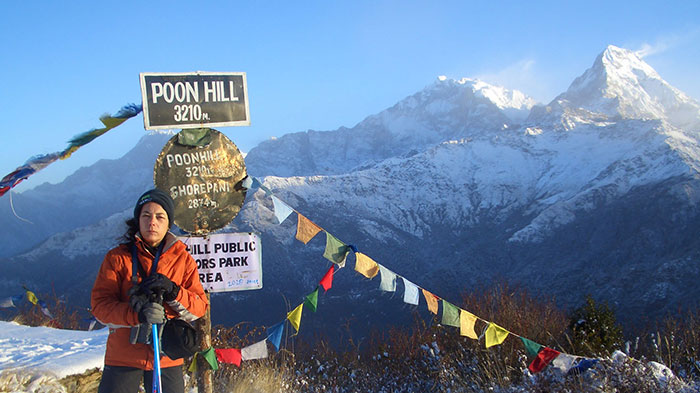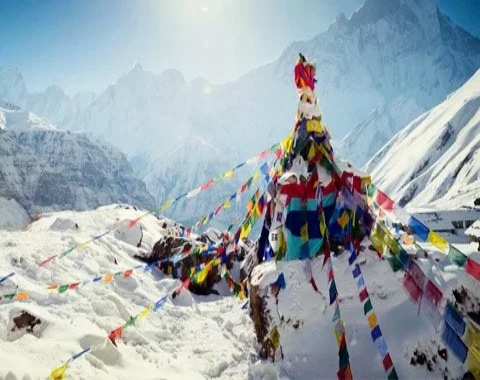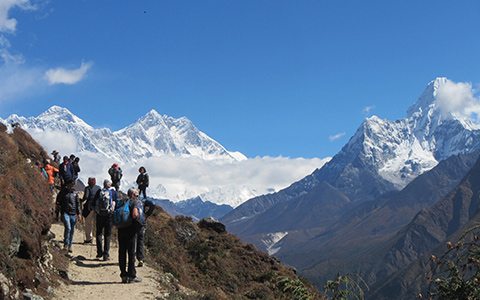Everest Base Camp Tour in Nepal in Winter
Winter in Nepal is the low season for trekking, and many people do not realize that it is possible to trek to Everest Base Camp (EBC) in Nepal in the coldest months of the year. While it may not be the height of the season, and a couple of walking poles (or even crampons) may be needed to get over the hard-packed, slippery snow in some places, trekking to Everest in the winter has its benefits. The trek passes by and through some of the most stunning scenery in the world, such as Kala Patthar, Tengboche Monastery, Namche Bazaar, and Khumbu Glacier, to name but a few.
While the peak seasons for trekking to EBC are normally from March to May and September to November, avid trekkers should not overlook the possibility of a winter trek. Temperatures can be a lot colder in winter than in the peak months, but the view of the landscape is often much better, and there are always more spaces at the trekking lodges in winter. Trekking in winter does not really need specialist equipment, but you do want to make sure your clothes are of the warmest type possible, as the temperatures can get very cold at night, even in the lodges.
Climate and Temperature for Winter EBC Trek in Nepal
The weather and climate in the Everest region are very unpredictable and should never be ignored or relied on. The climate and weather are very changeable and can go from bright sunshine one minute to the snowstorm the next, so keeping an eye on the weather is especially important in winter. Winter in Nepal is from December to February, and the coldest days at EBC can see temperatures as low as minus 17 degrees. Just as summer can see extremes of temperature and weather hitting as high as 24 degrees and intense downpours, so can the winter extremes be just as low. Winter is mainly dominated by the northeast monsoon, with the air streams bringing cold winds down from Mongolia and Siberia in Russia. It is this monsoon climate that is responsible for the cold and high winds.
 Nepal EBC Trek in Winter
Nepal EBC Trek in Winter
Days are shorter in the winter, which means you have less time to get to each lodge or guesthouse before dark and with a lot more snow on the ground, the going can be a lot harder, with the higher passes sometimes being closed. Daytime temperatures can be nice and warm, though, if you watch for the right window in the weather, and when it is clear, the weather is normally stable and dry making trekking possible.
Highlights and Benefits for Winter EBC Trek
During the winter months, very few people like to trek the route to EBC, as the cold is a huge put-off for most trekkers. But for those who are serious about trekking in more difficult conditions, or those who just want to avoid the crowds, winter is the ideal time to go there. During the peak months, Everest can get very crowded, with hundreds of thousands of people trekking the same trail to EBC. However, in winter, very few people trek this route, and if you do not mind the cold, winter is when you can have the mountain almost to yourself. You will see very few people on the route, which makes it more enjoyable when you get to those spots where the views are the best, and it makes for better photography in the winter.
Lodges are another good reason to trek in EBC in the winter months. In summer, many people find that, if they are late in the day getting to their next lodge for the night, that it is already full, and you can often see tents in the meadows and fields around the lodges, full of trekkers who knew they would not get accommodation. Unless you are using a guide who knows the lodge owners and can pre-book (something that individual trekkers cannot do), you are likely to find the peak months have no room.
 The lodges have plenty of room and you can have best views of the peak of Mount Everest
The lodges have plenty of room and you can have best views of the peak of Mount Everest
In winter, this is not a problem, as the lodges have plenty of room, although you do face another concern with the lodges at night. The temperature at night in the high-altitude area of the EBC trek can get very cold, with temperatures reaching as low as minus five or minus ten degrees. Lodges do not have central heating, and often the fire in the main lodge area is out at night, so a good thermal sleeping bag is needed. Staying warm is essential at high altitudes, and getting too cold can increase the risk of altitude sickness. However, all you need is a good arctic-rated sleeping bag, and the cold winter nights are no longer a problem.
Nepal EBC trekking route has a huge number of great viewpoints, where you can see many of the highest mountains in the world, including one which gives one of the best views of the peak of Mount Everest, Kala Patthar. Normally, in the peak months, these viewpoints are crowded with tourists, and getting a good view or a great photo can be next to impossible in the crowds of people, especially if you want to shoot the sunrise or sunset. Not only does the winter mean that the great viewpoints are not crowded with people, but it also means that you get to see the snow-covered landscape at its most beautiful, shining like a wintry wonderland at the high altitudes of the trekking route. A bright winter sunrise is invigorating, and an amazing sight as the sun comes up over the high Himalayas, and the delights of the sunset are just as amazing, with the mountains around you turning a burnished orange in the light of the dying embers of the sun.
Lower Altitude Trek Around EBC for Panoramic View of Everest (Below 4000m)
While it is possible to make the trip from Lukla to EBC in the winter, the extreme altitudes of the trek make it a hard route for inexperienced trekkers, and it is not advisable to take the trek in winter without some winter trekking experience. However, there are a number of shorter, lower altitude treks nearby, that not only give you an easier and more comfortable route, but which also provide some amazing views of the world’s tallest mountains.
 Poon Hill trek provides the excellent view of Mount Everest
Poon Hill trek provides the excellent view of Mount Everest
Poon Hill and Khopra Danda provide excellent treks for those who do not want a long trek at high altitudes. They are both extremely popular and offer some great views of other high mountains in the area, such as Annapurna, Dhaulagiri, and Machhapuchhre. For those who want to stay in the area of Everest, you do not have to go all the way to the base camp to get some great vistas of the mountain and the surrounding landscapes. From Lukla, you can take a short trek to Namche Bazaar, and then continue on up to the delightful village of Thame, famed for the beautiful monastery perched high on the cliffs above, and the picturesque views of the landscape in the valleys below. A little way up from Namche Bazaar is the village of Tengboche, home of the stunning Tengboiche Monastery, or trek along from Namche to Khumjung Village and visit the Khumjung Monastery.
The sights of the mountains around Tengboche are spectacular, and the view of Everest from the Everest View Hotel in Namche allows for sharper and more invigorating photos than you can get from higher elevations. For those who do not want to travel up too high, and Everest panorama trek is an ideal way to get the best of the region, without the extremes of Mount Everest.
How to Prepare for Winter EBC Trek in Nepal
Preparing for a trek in the Everest region in winter is an important part of the planning stage of the trip. If you are not well enough prepared, there is a chance you could end up ill, or worse. However, being over-prepared can be just as bad, since carrying all that unnecessary stuff halfway up the world’s highest mountain is going to be physically draining, and chances are you will not make it. A few tips on the preparation can help to make sure your trip to EBC is uneventful in terms of things going wrong, and as enjoyable as possible.
Altitude is a killer. If you are not prepared for the high altitudes of the EBC region, then you are going to find your trek cut short as you are rushed down to lower elevations to recover. Before you embark on your adventure, make sure that you understand the implications of altitude sickness, and are fully aware of all the symptoms and how to recognize them in yourself and others. Mild headaches, nausea, and general discomfort are usually the first symptoms that you will experience. If you do feel any of the symptoms, inform someone in your group, and rest at a lower altitude for a few days to recover. Correct acclimatization is important when ascending, and there are certain points along the trek that is ideal for this.
Weather is unpredictable in the mountains around Everest, and even if you are observant of the weather and the potential changes, there is no guarantee that you will not encounter a fast snowfall or even rain. If the weather looks to be turning bad, do not venture out of the lodge or campsite until it clears, and if caught out on the trail, move to the nearest lodge or village as quickly as possible.
Minor injuries such as sprains, bruises, etc., are sometimes unavoidable when trekking over rough terrain. Serious injuries are rare on the Everest trail, since it has been widely used for years, and are relatively safe. Make sure you pack a good first aid kit that can handle minor injuries. And in order to avoid such minor injuries in the first place, take care where you are walking, and it helps to have a hiking stick with you for extra support on very rough ground.
Staying warm in the winter is of paramount importance, especially with temperatures regularly reaching the minus figures. Multiple thinner layers of clothing are the best way to stay warm, as the layers trap the body heat in between them, keeping you warmer than when using a few thicker layers only. As mentioned, a good, arctic sleeping bag (with a 30-degree rating) will keep you warm enough in the lodges at night and is a good investment if you like to do winter trekking.
Good stout boots, the kind you find in the best trekking stores, are required for this kind of trek, and it is not advisable to trek the mountains in rubber shoes. Cleats or crampons are not really required, though some good trekking boots have small metal spikes on the soles to help with grip. And remember to take a hat and sunglasses, as well as sun cream and lip balm, as the sun can burn your skin even in winter at higher altitudes, and the winds are bitingly cold.
More Mount Everest Base Camp Travel Guide
 Mt.Everest Fact
Mt.Everest Fact- Everest Base Camp Nepal vs Everest Base Camp Tibet
- Mount Everest History and Its Famous Explorers
- The Difference of Mt.Everest in Nepal and Tibet
- Kathmandu to EBC Distance: how far and how to get to EBC in Nepal and Tibet from Kathmandu
- How Many Base Camps on Everest in Both Sides of Tibet and Nepal
 Everest Base Camp Tour Guide
Everest Base Camp Tour Guide- When is the Best Time to Visit Tibet Everest Base Camp in 2024
- When is the Best Time to Enjoy EBC Trek in Nepal
- The Best Hotel at Everest Base Camp in Tibetan Side
- Guide to Tibet Everest Base Camp Tour in Winter
- How to Get to Everest Base Camp (EBC) from Nepal?
- How to Get to Mount Everest Base Camp from Lhasa
- What Documents Do I Need for Everest Base Camp Tour in Tibet and Nepal?
 Everest Trekking Guide
Everest Trekking Guide- What to Pack for Everest Base Camp Trek
- Tingri to Everest Base Camp Trekking
- Everest Trek: Trekking Routes along The Gama Valley
- Everest Base Camp Trekking Maps in Tibet
- Ultimate Packing List for Everest Base Camp Trek in Tibet
- Best Trek in Nepal: Everest Base Camp Trek vs. Annapurna Circuit Trek
- Top 2 EBC Trekking Routes in Tibet
- EBC Trek in Tibet vs. EBC Trek in Nepal

Recommended Nepal Everest Base Camp Tour Packages
-
 Mount Everest Climbing Expedition in Nepal
Mount Everest Climbing Expedition in NepalTour Route:Kathmandu - Lukla - Phakding - Namche Bazaar - Tengboche - Dingboche - Duglha - Lobuche - Everest Base Camp - Mount Everest - Lukla - Kathmandu
-
 10 Days Everest Panorama View Trek Tour
10 Days Everest Panorama View Trek TourTour Route:Kathmandu - Lukla- Phakding- Namche Bazaar- Khumjung- Tengboche- Monjo- Kathmandu
-
 17 Days Nepal Everest Base Camp Trek Tour
17 Days Nepal Everest Base Camp Trek TourTour Route:Kathmandu - Phakding-Namche Bazaar-Tengboche- Dingboche- Lobuche-Gorakshep- Everest base camp-Kathmandu
-
 26 Days Everest Panoramic Trek in both Nepal and Tibet
26 Days Everest Panoramic Trek in both Nepal and TibetTour Route:Lhasa - Gyantse - Everest Base Camp - Gyirong Border - Rasuwagadhi - Kathmandu - Lukla - Phakding - Namche Bazaar - Everest Base Camp - Lukla - Kathmandu


.jpg)




0 Comment ON "Everest Base Camp Tour in Nepal in Winter"